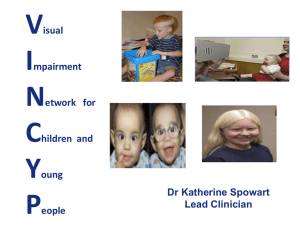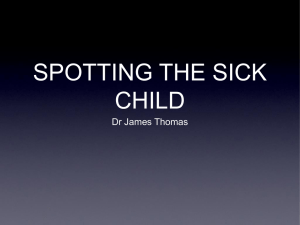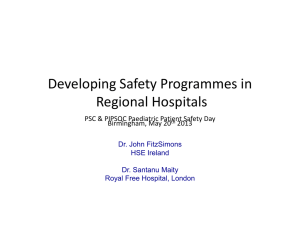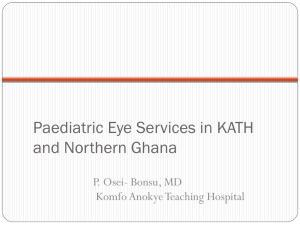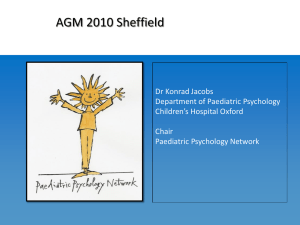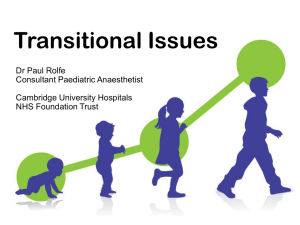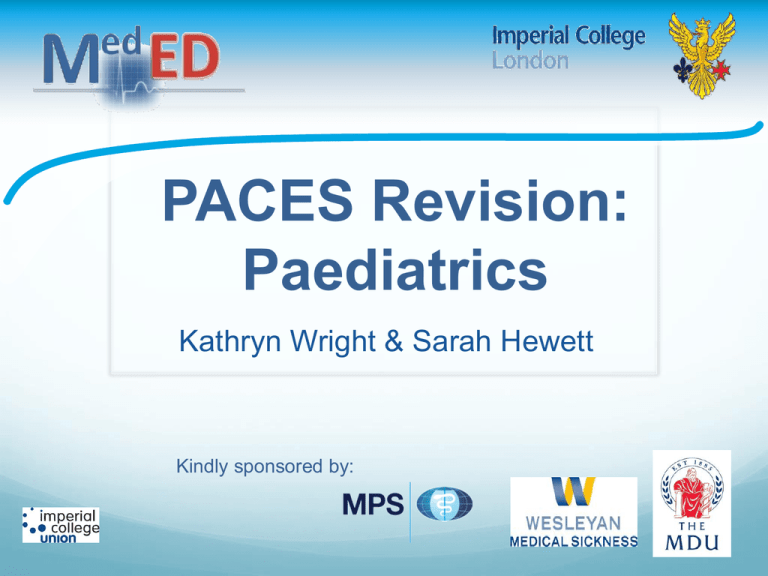
PACES Revision:
Paediatrics
Kathryn Wright & Sarah Hewett
Kindly sponsored by:
Schedule
• 9:00 - 10:00 Paediatrics PACES Talk + Questions
• 10:00 - 10:15 Practical demonstration of a station
• 10:30 - 11:00 – short break
station 1 - 11.00 - 11.35
station 2 - 11.40 - 12.15
station 3 - 12.20 - 12.55
station 4 - 13.00 - 13.35
The Objective
Know what to expect from a station
Know how to take the perfect history
Use your history to demonstrate your breadth of
knowledge
Be familiar with key topics
Know where to look for further resources
Feel more confident and less daunted by Paediatrics!
The plan
Introduction to PACES and paediatric stations
The handbook
The history
The examination
Hydration status and fluid management
Rashes
Paediatric emergencies
Non-accidental injuries
Paediatric ethics
The MDT
Handy hints and resources
Practice station
The plan
Introduction to PACES and paediatric stations
The handbook
The history
The examination
Hydration status and fluid management
Rashes
Paediatric emergencies
Non-accidental injuries
Paediatric ethics
The MDT
Handy hints and resources
Practice station
PACES
Practical Assessment of Clinical Examination Skills
This will assess your history, examination and
communication skills in six 15 minute stations
Can’t fail on one station
Expect overlap between specialties
Teen - depression/substance abuse/self harm/poor compliance
Teen - contraception: competence/confidentiality
GP - Rash/vaccinations/development
COMMUNICATION skills
The Paediatric station
May or may not have a patient in
History
Examination/explain how you would
examine/examination findings
Investigations/management/questions around a topic
Discussion with family – answer questions, explain,
reassure, ICE
SAFETY NET!!
The plan
Introduction to PACES and paediatric stations
The handbook
The history
The examination
Hydration status and fluid management
Rashes
Paediatric emergencies
Non-accidental injuries
Paediatric ethics
The MDT
Handy hints and resources
Practice station
The Handbook
History
Examination
Key topics
Emergency algorithms’
Top tips and handy hints
The plan
Introduction to PACES and paediatric stations
The handbook
The history
The examination
Hydration status and fluid management
Rashes
Paediatric emergencies
Non-accidental injuries
Paediatric ethics
The MDT
Handy hints and resources
Practice station
The history
By taking a history you aim to show the examiner your
thought process:
Consider all differentials
Narrow the diagnosis down
Place the child in context
Show your communication skills
History Overview
Introduction
Presenting complaint
Systems review
Past medical history
Developmental
Family
Social
Adolescent Questions
Conclusions
Introductions
Who are you you
Who is the patient
Who is with them
What are you there for
Presenting Complaint
Open ended questions
The main cause for concern
Associated symptoms
Time frame + duration
Why have they come to you
Our patient
Lucy, 3 years old
PC: Does not seem herself, C/O abdominal pain
Last couple of days
Some diarrhoea, 1 episode of vomiting
Not wanting to E+D much
PU – reduced volume
Low grade fevers
Systems review
General – fever, skin colour, sleep, weight loss
Cardio – sweating, cyanosis, pallor, SOB, faints
Resp – coryza, sore throat, earache, cough, wheeze, SOB,
snoring
Gastro – infant feeding, appetite, diet, vomiting, abdo pain,
distention, bowel habit
Urological – passing urine, enuresis, dysuria
Neuro – headache, fits, hearing, vision
Musc – limp, joint or limb pain, swollen joint, gait
Derm – lumps or bumps, rashes
Our patient
Lucy, 3 years old
PC: not herself, abdo pain, mild D&V, reduced oral
intake, low grade fevers
SR:
Lethargic
URTI last week
Limping since yesterday
Small dark red spots over her bottom
Past medical hx
Specific questions to paeds:
Pregnancy and birth
Feeding
Previous admissions
Common conditions
Drug history
Allergies
Vaccinations
The vaccination schedule
This is on page 47 of the guide
Common theme in PACES
Always check they are up to date, check the red book.
If not ask why
Reassurance about the safety of immunisation
Importance of herd immunity
Also, for at risk groups, BCG and HBV at birth
Our patient
Lucy, 3 years old
PC: not herself, abdo pain, mild D&V, reduced oral
intake, low grade fevers
SR: Lethargic, URTI last week, limping since yesterday,
small dark red spots over her bottom
Pmhx:
Nil of note
UTD with vaccinations –3 yr booster 10 days ago
Developmental
On page 45 of your handbook
Limited in a systems review
Ask parents if they have any concerns, is the child
doing what they would expect (easier if not the 1st child)
Screening with red flag signs
Could be shown a video
Could be asked “what you you expect of a child of this
age?”
Some examples of
development
Developmental red flags
Age
Features
Any age
Maternal concern
10 wks
Not smiling
6 mths
Persistent primitive reflexes
Hand preference
Persistent squint
Little interest in people, toys or noises
10-12
mths
No sitting
No pincer grasp
18 mths
Not walking independently
Regression of any previously acquired skill
No double-syllable babble
Fewer than 6 words
2.5 yrs
No 2-3 word sentences
4 yrs
Unintelligible speech
Persistent mouthing or drooling
Family history
Who is in the house?
Parents and sibling most important but ask about whole
family.
Consanguinity
Always draw a family tree!
Social history
Who is at home?
School/day care?
Anyone else unwell?
Smokers, pets at home, (if relevant)
Adolescent questions
Home – relationships/problems
Education/Employment – problems
Alcohol
Drugs – smoking, illicit, tried/regular use
Sex – orientation, active, partner, contraception, STIs,
menstrual history
Our patient
Lucy, 3years old
PC: not herself, abdo pain, mild D&V, reduced oral intake,
low grade fevers
SR: Lethargic, URTI last week, limping since yesterday,
small dark red spots over her bottom
Pmhx: Nil of note, recent vaccinations
Fhx/Shx:
normal development
Lives with parents and older sister who has also been coryzal
recently
Conclusions
Summarize back to the family/patient
Ask if you have missed any thing
Is there anything else concerning them?
Is there anything they would like to ask you?
Do not forget to look at the red book
Our Patient
Diagnosis HSP
PACES questions
Examination findings
Investigations, management
Pathology behind the diagnosis
May be asked to speak to the parents;
Chance to show communication skills
Jargon free explanations
Reassurance
Offer written as well as verbal advice
The plan
Introduction to PACES and paediatric stations
The handbook
The history
The examination
Hydration status and fluid management
Rashes
Paediatric emergencies
Non-accidental injuries
Paediatric ethics
The MDT
Handy hints and resources
Practice station
Examination
Pages 38 - 40 in the handbook
Detail is beyond the scope of this lecture but a few keys
points….
General appearance
Hernias & genitalia
ENT
Skin
Hydration status
Utilise parents, nurses, play specialists
Make it fun!
The plan
Introduction to PACES and paediatric stations
The handbook
The history
The examination
Hydration status and fluid management
Rashes
Paediatric emergencies
Non-accidental injuries
Paediatric ethics
The MDT
Handy hints and resources
Practice station
Hydration status
Fluid resuscitation
Correcting shock:
IV rehydration: 20ml/kg bolus of 0.9% saline. If still
shocked then PICU
If shock resolves then: IV 100ml/kg 0.9% saline over 4hrs
plus maintenance
Maintenance:
Body Weight
Fluid Requirement over 24
hours
Volume/kg/hour
First 10kg
100 ml/kg
4ml
Second 10kg
50 ml/kg
2ml
Each kg thereafter
20 ml/kg
1ml
Vital signs in children
The plan
Introduction to PACES and paediatric stations
The handbook
The history
The examination
Hydration status and fluid management
Rashes
Paediatric emergencies
Non-accidental injuries
Paediatric ethics
The MDT
Handy hints and resources
Practice station
Describing a rash
What if you can’t guess what it is??
Describe what you see:
http://dermnetnz.org/terminology.html
Derm net Nz: great lesion terminology and photos, good
for derm revision too!
Describing a lesion
INSPECT in general
Site and number of lesion(s)
Pattern of distribution and configuration
DESCRIBE the individual lesion
SCAM
Size (the widest diameter)
Shape
Colour
Associated secondary change
Morphology, Margin (border)
ABCD: If Pigmented, increased chance of malignancy:
Asymmetry (lack of mirror image in any of the four
quadrants)
Irregular Border
Two or more Colours within the lesion
Diameter > 7mm
PALPATE the individual lesion
Surface Consistency Mobility Tenderness Temperature
SYSTEMATIC CHECK
Examine the nails, scalp, hair & mucous membranes
General examination of all systems
The plan
Introduction to PACES and paediatric stations
The handbook
The history
The examination
Hydration status and fluid management
Rashes
Paediatric emergencies
Non-accidental injuries
Paediatric ethics
The MDT
Handy hints and resources
Practice station
Basic Life Support
Other Emergencies
Pages 48 – 58 of your guide
Shock/sepsis
Acute Asthma
Anaphylaxis
DKA
Epilepsy/status/febrile fits
The plan
Introduction to PACES and paediatric stations
The handbook
The history
The examination
Hydration status and fluid management
Rashes
Paediatric emergencies
Non-accidental injuries
Paediatric ethics
The MDT
Handy hints and resources
Practice station
Non Accidental Injury
More details in your guide, page 61
Different types of abuse
Physical/emotional/neglect/sexual
General appearance?
Growth, development, demeanor, clothing, hygiene
How did they present?
Delayed, who brought them in
History – does the mechanism fit the injury
Plausible, possible
Consistent
The plan
Introduction to PACES and paediatric stations
The handbook
The history
The examination
Hydration status and fluid management
Rashes
Paediatric emergencies
Non-accidental injuries
Paediatric ethics
The MDT
Handy hints and resources
Practice station
Consent + Competence
Family Law Reform Act 1969: children age 16 and over
are deemed competent to consent
Gillick competence: sufficiently mature to:
Understand the nature, purpose, risks
Understand the alternatives
Must be decided on a case to case basis
The plan
Introduction to PACES and paediatric stations
The handbook
The history
The examination
Hydration status and fluid management
Rashes
Paediatric emergencies
Non-accidental injuries
Paediatric ethics
The MDT
Handy hints and resources
Practice station
The MDT
The usual suspects:
Dr’s from all specialties
Nurses + specialty nurses (CF, asthma etc)
OT + PT
Paeds specific:
Community paediatricians
School teachers and nurse
Social workers
Play specialists
CAMHS
The plan
Introduction to PACES and paediatric stations
The handbook
The history
The examination
Hydration status and fluid management
Rashes
Paediatric emergencies
Non-accidental injuries
Paediatric ethics
The MDT
Handy hints and resources
Practice station
Handy hints
Be familiar with the red book
Know how plot and read off a growth chart
Know your milestones and vaccination schedule
Be aware of age and its influence on presentations
Listen carefully to pick up all clues
Common things are common!
Practice, practice, practice!
Exam resources
Lissauer
“Get ahead” books
Core Clinical Cases
Clinical Cases Uncovered
100 cases in paediatrics
MedEd handbook
Patient.co.uk
Royal college websites: RCPCH, BTS, Resuscitation
Council
Thank you for listening!
Please fill in the feedback forms, helpful to us and
helpful for improving this course for future years!
Example case coming up if you would like to stay
First of the stations starts at 11:00
QUESTIONS???
The plan
Introduction to PACES and paediatric stations
The handbook
The history
The examination
Hydration status and fluid management
Rashes
Paediatric emergencies
Non-accidental injuries
Paediatric ethics
The MDT
Handy hints and resources
Practice station
The Mock Station


